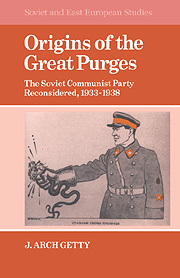Book contents
- Frontmatter
- Contents
- List of tables
- Preface
- Introduction: the Great Purges as history
- 1 The Communist Party in the thirties
- 2 What was a purge?
- 3 The Verification of Party Documents of 1935: a case study in bureaucratic ineptitude
- 4 Radicalism and party revival
- 5 Radicalism and enemies of the people
- 6 The crisis matures: 1937
- 7 Epilogue: the Ezhovshchina
- Conclusion: some observations on politics in the thirties
- Appendix: the Kirov assassination
- Bibliographic essay
- Notes
- Index
- SOVIET AND EAST EUROPEAN STUDIES
Introduction: the Great Purges as history
Published online by Cambridge University Press: 23 September 2009
- Frontmatter
- Contents
- List of tables
- Preface
- Introduction: the Great Purges as history
- 1 The Communist Party in the thirties
- 2 What was a purge?
- 3 The Verification of Party Documents of 1935: a case study in bureaucratic ineptitude
- 4 Radicalism and party revival
- 5 Radicalism and enemies of the people
- 6 The crisis matures: 1937
- 7 Epilogue: the Ezhovshchina
- Conclusion: some observations on politics in the thirties
- Appendix: the Kirov assassination
- Bibliographic essay
- Notes
- Index
- SOVIET AND EAST EUROPEAN STUDIES
Summary
Each says something about the nature of the world, and, though individually he adds little or nothing to our understanding of it, still from the combination of all something considerable is accomplished.
AristotleUntil Khrushchev's time, Soviet citizens were taught that the Communist Party had uncovered a dangerous conspiracy in the mid-1930s. According to the official Stalinist view, it had gradually come to light in 1934–6 that many of the party's prominent personalities had been undercover “enemies” of the party who had worked to undermine the party and the Soviet regime from the earliest days of Soviet power. Led primarily by Leon Trotsky, this “gang” of “fiends” included other longtime Bolsheviks Grigorii Zinoviev, Nikolai Bukharin, Lev Kamenev, Aleksei Rykov, and others who had posed as Lenin's trusted comrades. These traitors had always been spies, saboteurs, and oppositionists who wanted to overthrow the socialist regime, split the party, and ultimately restore capitalism in the USSR. They plotted with the German Gestapo to overthrow the party leadership in a bloody coup that was timed to coincide with the invasion of the USSR by one or more fascist states. In a series of major public trials, these traitors were unmasked by the secret police and the party, whose vigilance had discovered the treason. The plotters admitted their guilt in open court, and the Soviet people were unanimous in their condemnation of the treason. The vigilant secret police justly uprooted the treason, followed proper judicial norms, punished only the guilty, and ultimately saved the Soviet government.
Western specialists and Soviet dissidents have provided another explanation of these events that is more complicated but ultimately as Manichean as the Stalinist story.
- Type
- Chapter
- Information
- Origins of the Great PurgesThe Soviet Communist Party Reconsidered, 1933–1938, pp. 1 - 9Publisher: Cambridge University PressPrint publication year: 1985



